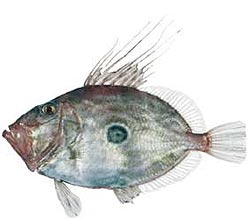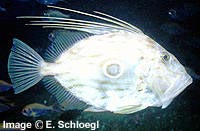: Zeus faber
Phylum Chordata
John Dory inhabit the Southern coastal waters of Australia from from QLD to south WA including Tasmania. They are a bottom dwelling fish often found in deep offshore waters close to reef or rock structures, deep channels of bays and harbors, large estuaries and around deep water wharves. During winter migration leads to John Dory entering shallower waters of estuaries, bays and harbors along the east coast of Australia. They are also found in the Western Indian Ocean, eastern Atlantic Ocean, Mediterranean Sea and the waters of New Zealand and Japan.
John Dory, is an edible deep-sea fish with a laterally compressed olive-yellow body which has a large dark spot, and long spines on the dorsal fin. The dark spot is used to flash an 'evil eye' if danger approaches the John Dory. This species is dark brown as juveniles and silvery The John Dory grows to a maximum size of 65cm and 3kg in weight. It has 10 long spines on its dorsal fin and 4 spines on its anal fin. It has microscopic, sharp scales that run around the body. The fish is an olive green color with a silvery white belly and has a dark spot on its side. Its eyes are near the top of its head. It has a flat, round body shape and is a poor swimmer.
They live near the seabed, living in depths from 5 meters to 360 meters .They are normally solitary. The John Dory is the top predator in its habitat. It usually gets its food by stalking it then shooting out a tube in its mouth to capture its prey. In one quick motion it drops the "trapdoor" lower jaw, shoots out the upper jaw, and expands the gill cavity, sucking in the hapless prey along with a considerable volume of water. The John Dory eats a variety of fish eg young herrings,sand eels,pilchards, especially schooling fish, such as sardines. Occasionally they eat squid and cuttlefish.
|


|
Their predators are sharks, like the dusky shark, and other large bony fish. After they are 3 or 4 years of age they are usually ready to reproduce. This happens around the end of winter. They are substrate scatterers, which means that they release sperm and eggs into the water to fertilize. The eggs and larvae are pelagic; the eggs are small (0.1 in or 2 mm diameter) and spherical, with a large oil globule. No nest building or parental care has been reported for the species.Typical lifespan is about 12 years in the wild.
The John dory is prized as a food fish and is of commercial importance because of its high price in fish markets.
As of 1998 there were no regulations regarding John dory fishery in Australian waters and it is not on any endangered or vulnerable list. The species is taken as bycatch in the trawl fisheries of the eastern Atlantic, South Africa, Australia, New Zealand, Indonesia, Philippines, Taiwan, and Japan.
|